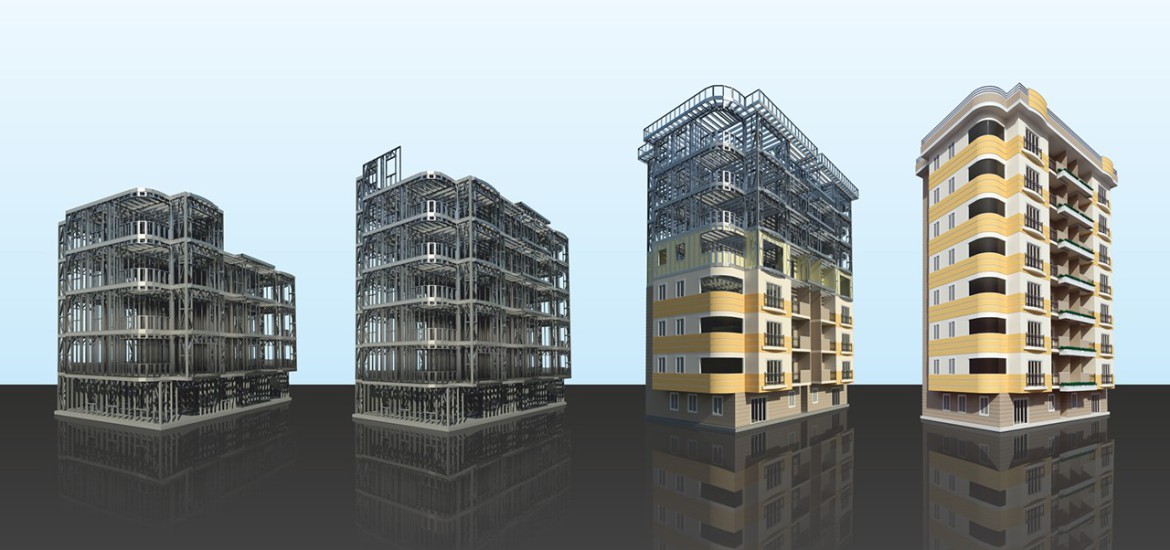Steelin
Light Gauged Steel Construction SystemsLight Steel Structures Turns into Art… Which One Is Your Steelin?
Be ready to see multi-storey light steel structures around you…
Light steel structures, which were only possible up to four storeys maximum until now, can go up to eight storeys by means of technology and design developed by Steelin.
Workshop, warehouse, hangar, factory… Steelin which has wide space functionality, satisfy the need as a hangar for a large airplane as well as a factory with long spans.
Steel Buildings Systems
Steel frame buildings combine durability, efficiency, and modern design. Ideal for residential, commercial, and industrial use, they offer quick installation, low maintenance, and long-term value. With sustainable materials and energy-efficient options, steel structure systems are a smart choice for innovative construction projects. Their strength and flexibility make them a leading solution in today’s building industry.
What Is a Steel Building?
A steel building is primarily made from steel components that provide strong and durable support. Unlike traditional buildings that rely on wood or concrete for the framework, steel frame buildings utilize steel frame construction methods for enhanced stability and resistance. These buildings are often designed as prefabricated steel structures, allowing for faster assembly and fewer on-site labor requirements.
The core of a steel-framed building lies in its steel frame structure, which consists of columns, beams, and girders meticulously assembled to create a robust skeleton. Known for their load-bearing strength, these buildings can be used in residential, commercial, and industrial steel building applications.
Features of Steel Building Systems
Steel frame buildings are known for their precision engineering and modern aesthetics. One of the main advantages is the adaptability of the steel frame system, which can accommodate a wide range of architectural designs. From minimalist structures to complex layouts, the steel frame structure allows maximum design flexibility. It also simplifies the integration of large open spaces without the need for interior support columns, making steel-frame houses and metal buildings highly functional.
Another feature is modularity. In steel modular construction, the building components are pre-engineered and manufactured off-site, which reduces on-site waste and shortens the construction timeline. These systems also use high-quality coatings and corrosion-resistant alloys, ensuring that the steel-framed buildings can stand the test of time.
Installation Methods for Steel Building Systems
The installation of steel frame metal buildings follows a systematic and efficient process, often carried out in less time compared to traditional construction methods. The prefabricated components of a steel frame building are delivered to the site ready for assembly, significantly reducing construction time and errors. This process is commonly referred to as steel skeleton frame construction, where pre-cut and pre-drilled steel parts are bolted or welded together.
Different steel frame construction methods are used depending on the building’s size and purpose. For instance, steel buildings UK commonly adopt portal frame systems for warehouses and industrial structures due to their cost-effectiveness and ease of expansion. For steel frame homes, lighter framing systems are preferred, providing both strength and flexibility. In all applications, steel frame construction offers consistency, safety, and structural integrity from start to finish.
Advantages of Using Steel Buildings
The popularity of steel buildings has grown significantly due to their strength, speed of installation, and long-term cost savings. A steel structure offers high load-bearing capacity, allowing for larger interior spans and more usable space. In modern construction, steel frame construction provides superior flexibility in design while maintaining robust support, making it suitable for both steel frame houses and large-scale industrial steel buildings.
In addition to structural advantages, steel framed buildings are also environmentally conscious. Steel is recyclable and reusable, making steel modular construction a sustainable choice. Whether you’re opting for steel frame homes or commercial metal frame buildings, the eco-friendly nature of steel frame construction methods supports green building initiatives and reduces the overall carbon footprint of the project.
Low Maintenance Requirements
One of the major benefits of steel frame buildings is their low maintenance needs. Unlike wood, steel does not warp, crack, or attract pests, which reduces the frequency and cost of repairs. Steel frame metal buildings require minimal upkeep and are often treated with coatings that resist rust and corrosion, ensuring long-term durability for metal buildings of all types.
Resistance to Harsh Weather Conditions
Steel buildings are highly resistant to extreme weather, including high winds, heavy snow, and earthquakes. The resilience of the steel frame structure allows it to withstand environmental stress without compromising safety. This makes building with steel frame a smart investment in regions prone to natural disasters, ensuring that both steel frame houses and commercial buildings remain secure.
Common Usage Areas of Steel Buildings
Steel frame building construction is widely used across numerous sectors due to its adaptability and cost-efficiency. In the industrial sector, industrial steel buildings are essential for factories, storage facilities, and warehouses. These structures often rely on steel skeleton frame construction to support heavy equipment and open floor layouts.
In the residential market, steel frame homes are becoming more popular thanks to their modern aesthetic and longevity. From urban housing projects to countryside retreats, steel frame houses offer style without compromising on durability.
Steel Buildings for Sale
With increasing demand across various industries, steel buildings for sale are available in a wide range of sizes, designs, and configurations. These pre-engineered systems are ideal for customers seeking efficient, ready-to-install solutions. Whether it’s a small storage unit or a large-scale warehouse, steel frame metal buildings offer customization options that suit diverse needs and budgets.
Many suppliers offer standard models of steel frame buildings, which can be delivered quickly and assembled on-site with minimal delays. For those needing a tailored approach, options are available for customized steel frame houses, metal frame buildings, or industrial steel buildings.
Steel Building Pricing
The cost of a steel framed building can vary based on several factors such as size, complexity, location, and customization. Basic metal buildings tend to have lower upfront costs compared to traditional construction, largely due to reduced labor and faster installation times. However, if you require a unique design or high-end finishes, prices may increase accordingly.
Another important element affecting steel building pricing is the choice of materials and steel frame construction methods. Galvanized or coated steel, for instance, can raise the cost but also enhances the building’s durability and resistance. Whether you’re investing in steel frame homes or commercial steel buildings, it’s essential to evaluate both short- and long-term costs to get the best value for your investment.
Things to Consider When Buying Steel Building Profiles
Choosing the right profile is crucial when purchasing steel frame building construction materials. The profile determines the structure’s load capacity, insulation compatibility, and architectural flexibility. Buyers should consider the building’s intended use, climate conditions, and compliance with local building codes. For example, steel buildings UK may require specific design criteria due to environmental regulations and weather patterns.
Additionally, pay attention to the manufacturing standards and quality certifications of the materials. Reputable suppliers will provide detailed specifications and performance data to help you choose between light or heavy-duty steel frame systems. Whether for steel frame homes or modern steel structures, selecting the right profile ensures long-term performance and safety.
How to Order a Custom Steel Building System?
Ordering a custom steel building system begins with a clear understanding of your project requirements. The process typically starts with selecting a building type—whether it’s for residential, commercial, or industrial use. Next, you’ll decide on the size, height, and layout of the structure. Custom steel frame houses and steel modular construction options allow you to tailor everything from roof pitch to door placements, making your steel structure highly functional and efficient.
After finalizing the design, you’ll work closely with the manufacturer or supplier to approve architectural drawings and material specifications. Most steel buildings for sale come with engineering support to ensure the final product meets building codes and zoning laws. From metal frame buildings to complex steel-framed buildings, the ability to customize provides clients with exactly what they need while maintaining all the benefits of steel frame construction.
Key Considerations When Requesting Custom Building Panels
When requesting custom panels for your steel frame system, make sure to account for insulation, ventilation, and structural performance. Different applications—such as steel frame homes versus industrial steel buildings—will require different panel thicknesses, coatings, and structural load ratings. Also, consider how the panels will integrate with the rest of the steel skeleton frame construction.
Maintenance and Longevity of Steel Buildings
One of the standout benefits of steel frame buildings is their exceptional longevity. With proper care, steel framed buildings can last 50 years or more. The material is resistant to fire, moisture, pests, and corrosion, especially when treated with high-performance coatings. This makes building with steel frame one of the most durable choices for long-term property investments.
Routine maintenance for metal buildings is minimal and generally includes periodic inspections of fasteners, joints, and coatings. Keeping drainage systems clean and checking for surface wear ensures your steel frame building construction remains in top condition. Over time, this low-maintenance requirement translates into significant cost savings, particularly when compared to wood or masonry alternatives.
Insulation and Energy Efficiency in Steel Buildings
Modern steel buildings can be designed with excellent thermal performance through proper insulation and ventilation systems. High-quality insulation materials used in steel frame construction help reduce energy consumption for heating and cooling. As a result, steel frame houses and commercial metal buildings become more sustainable and economical over time.
Energy efficiency is further enhanced when using reflective roofing and wall panels. These additions reduce heat gain, making steel frame metal buildings ideal for both hot and cold climates. Many steel buildings UK projects now include green building features, helping property owners reduce utility bills while minimizing environmental impact. With thoughtful planning, a steel framed building can meet or exceed energy performance standards.

